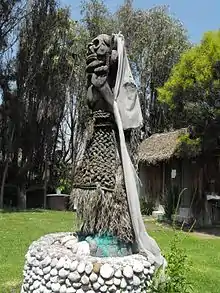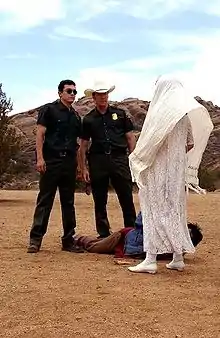La Llorona
In Latin American folklore, La Llorona (Spanish: [la ʝoˈɾona]; "The Weeping Woman" or "The Wailer") is a ghost who roams waterfront areas mourning her drowned children.[1]

In a typical version of the legend, a beautiful woman named Maria marries a rich ranchero with whom she bears two children. One day, Maria sees her husband with another woman and in a fit of blind rage, she drowns their children in a river, which she immediately regrets. Unable to save them and consumed by guilt, she drowns herself as well but is unable to enter the afterlife without her children.[2] In another version of the story, her children are illegitimate, and she drowns them so that their father can not take them away to be raised by his wife.[3] Recurring themes in variations on the La Llorona myth include white dresses, nocturnal wailing, and an association with water.[4]
Origins
The legend of La Llorona is traditionally told throughout Latin America, including Mexico, Central and South America.[5] La Llorona is sometimes conflated with La Malinche,[6] the Nahua woman who served as Hernán Cortés' interpreter and also bore his son.[7] La Malinche is considered both the mother of the modern Mexican people and a symbol of national treachery for her role in aiding the Spanish.[8]
Stories of weeping female phantoms are common in the folklore of both Iberian and Amerindian cultures. Scholars have pointed out similarities between La Llorona and the Cihuacōātl of Aztec mythology,[5] as well as Eve and Lilith of Hebrew mythology.[9] Author Ben Radford's investigation into the legend of La Llorona, published in Mysterious New Mexico, found common elements of the story in a German folktale dating from 1486.[10] La Llorona also bears a resemblance to the ancient Greek tale of the demigodess Lamia, in which Hera, Zeus' wife, learned of his affair with Lamia and killed all the children Lamia had with Zeus. Out of jealousy over the loss of her own children, Lamia kills other women's children.[11]
While the roots of the La Llorona legend appear to be pre-Hispanic,[12] the earliest published reference to the legend is a 19th century sonnet by Mexican poet Manuel Carpio.[5] The poem makes no reference to infanticide, rather La Llorona is identified as the ghost of a woman named Rosalia who was murdered by her husband.[13]
Per region
In Mexico
The legend of La Llorona is deeply rooted in Mexican popular culture, her story told to children to encourage them not to wander after dark, and her spirit often evoked in artwork,[14] such as that of Alejandro Colunga.[15] "La Cihuacoatle, Leyenda de la Llorona" is a yearly waterfront theatrical performance of the legend of La Llorona set in the Xochimilco borough of Mexico City,[16] established in 1993 to coincide with the Day of the Dead.[17]
In the United States
In the Southwestern United States, the story of La Llorona is told to scare children into good behavior,[18] sometimes specifically to deter children from playing near dangerous water. [19] In Chumash mythology indigenous to Southern California, La Llorona is linked to the nunašɨš, a mythological creature with a cry similar to that of a newborn baby.[20]
In Venezuela
In Venezuelan folklore La Llorona was a woman who had to raise her child alone after the father died in war. She eventually killed the child in frustration, and her spirit now kidnaps and kills other people's children.[21] Families traditionally placed wooden crosses above their doors to ward off such spirits.[22]
In popular culture
Film

The story of La Llorona first appeared on film in 1935's La Llorona, filmed in Mexico.[23] René Cardona's 1960 movie La Llorona was also shot in Mexico,[24] as was the 1963 horror film, The Curse of the Crying Woman directed by Rafael Baledón.[25]
The 2008 Mexican horror film Kilometer 31[26] is inspired by the legend of La Llorona.[27] Additionally the early 2000s saw a spate of low-budget movies based on La Llorona, including:
La Llorona is the primary antagonist in the 2007 movie J-ok'el.[31] In the 2011 Mexican animated film La Leyenda de la Llorona, she is portrayed as a more sympathetic character, whose children die in an accident rather than at their mother's hands.[32]
In July 2019, James Wan, Gary Dauberman and Emilie Gladstone produced a film titled The Curse of La Llorona. The film is the sixth installment in The Conjuring Universe, produced by New Line Cinema and Warner Bros. Pictures. The film was directed by Michael Chaves and stars Linda Cardellini, Raymond Cruz, Patricia Velasquez and Marisol Ramirez, who portrays the ghost.[33]
Also in 2019, Jayro Bustamante directed the Guatemalan film La Llorona, starring María Mercedes Coroy, which screened in the Contemporary World Cinema section at the 2019 Toronto International Film Festival.[34]
Theater
Mexican playwright Josefina López wrote "Unconquered Spirits",[35] which uses the myth of La Llorona as a plot device. The play premiered at California State University, Northridge's Little Theatre in 1995.[36]
Literature
Nancy Farmer's 2002 science fiction novel, The House of the Scorpion includes references to La Llorona.[37]
The legend of La Llorona is discussed in Jaquira Díaz's 2019 memoir, Ordinary Girls:
“The scariest part was not that La Llorona was a monster, or that she came when you called her name three times in the dark, or that she could come into your room at night and take you from your bed like she'd done with her own babies. It was that once she'd been a person, a woman, a mother. And then a moment, an instant, a split second later, she was a monster.”[38]
Music
"La Llorona" is a Mexican folk song popularized by Andres Henestrosa in 1941.[39] It has since been covered by various musicians, including Chavela Vargas,[40] Joan Baez,[41] and Lila Downs.[42]
Television
La Llorona is an antagonist in the 2005 pilot episode of the TV series Supernatural,[43] and in a 2012 second season episode of the TV series Grimm.[44]
See also
References
- Christine Delsol (9 October 2012). "Mexico's legend of La Llorona continues to terrify". sfgate.com. Retrieved 7 October 2020.
- Christine Delsol (9 October 2012). "Mexico's legend of La Llorona continues to terrify". sfgate.com. Retrieved 7 October 2020.
- Simerka, Barbara (2000). "Women Hollering: Contemporary Chicana Reinscriptions of La Llorona Mythography" (PDF). Confluencia. 16 (1): 49–58.
- Carbonell, Ana María (1999). "From Llorona to Gritona: Coatlicue in Feminist Tales by Viramontes and Cisneros" (PDF). MELUS. 24 (2): 53–74. doi:10.2307/467699. JSTOR 467699.
- Werner 1997, p. 753.
- Leal, Luis (2005). "The Malinche-Llorona Dichotomy: The Origin of a Myth". Feminism, Nation and Myth: La Malinche. Arte Publico Press. p. 134. OCLC 607766319.
- Hanson, Victor Davis (2007-12-18). Carnage and Culture: Landmark Battles in the Rise to Western Power. Knopf Doubleday Publishing Group. ISBN 978-0-307-42518-8.
- Cypess, Sandra Messinger (1991). La Malinche in Mexican Literature: From History to Myth. Austin, TX: University of Texas Press. ISBN 9780292751347.
- Norget 2006, p. 146.
- Radford, Ben (2014). Mysterious New Mexico. Albuquerque: University of New Mexico Press. p. 228. ISBN 978-0-8263-5450-1.
While the classic image of La Llorona was likely taken from an Aztec goddess named Cihuacōātl, the narrative of her legend has other origins. As Bacil Kirtley (1960) wrote in Western Folklore, "During the same decade that La Llorona was first mentioned in Mexico, a story, seemingly already quite old, of 'Die Weisse Frau' ('The White Lady')—which reproduces many of the features consistently recurring in the more developed versions of 'La Llorona', was recorded in Germany"; references to Die Weisse Frau date back as early as 1486. The story of the White Lady follows a virtually identical plot to the classical La Llorona story.
- Folklore: In All of Us, In All We Do. University of North Texas Press. 2006. p. 110. ISBN 9781574412239.
- Leal, Luis (2005). "The Malinche-Llorona Dichotomy: The Origin of a Myth". Feminism, Nation and Myth: La Malinche. Arte Publico Press. p. 134. OCLC 607766319.
- Carpio, Manuel (1879). Poesias del Sr. Dr. Don Manuel Carpio con su biografia escrita por el Sr. Dr. D. José Bernardo Couto. Mexico: La Enseñanza. p. 299.
- Ibarra, Enrique Ajuria (2014). "Ghosting the Nation: La Llorona, Popular Culture, and the Spectral Anxiety of Mexican Identity". The Gothic and the Everyday. London: Palgrave Macmillan. pp. 131–151. doi:10.1057/9781137406644_8. ISBN 978-1-349-48800-1.
- Coerver, Don M. (2004). Mexico: An Encyclopedia of Contemporary Culture and History. ABC-CLIO. ISBN 9781576071328.
- RJ Marquez (2019). "Mysterious tales behind La Llorona, Island of the Dolls in Mexico City". ksat.com. Retrieved 8 October 2020.
- Winnie Lee (30 October 2019). "How Mexico's Most Sorrowful Spirit Became a Cultural Phenomenon". atlasobscura.com. Retrieved 7 October 2020.
- Leddy, Betty (1988). "La Llorona in Southern Arizona" (PDF). Perspectives in Mexican American Studies. q: 9–16.
- Raheem, N.; Archambault, S.; Arellano, E.; Gonzales, M.; Kopp, D.; Rivera, J.; Guldan, S.; Boykin, K.; Oldham, C.; Valdez, A.; Colt, S.; Lamadrid, E.; Wang, J.; Price, J.; Goldstein, J.; Arnold, P.; Martin, S.; Dingwell, E. (2015-06-08). "Aframework for assessing ecosystem services in acequia irrigation communities of the Upper Río Grande watershed". Wiley Interdisciplinary Reviews: Water. Wiley. 2 (5): 559–575. doi:10.1002/wat2.1091. ISSN 2049-1948.
- Blackburn, Thomas C. (1975). December's Child: A Book of Chumash Oral Narratives. University of California Press. ISBN 9780520029309.
- Francisco Serrano Cendejas (30 April 2019). "La Llorona in Venezuela". folklore.usc.edu/. Retrieved 8 October 2020.
- Dinneen, Mark (2001). Culture and Customs of Venezuela. Greenwood Publishing Group. ISBN 978-0-313-30639-6.
- "The Crying Woman (1933)". IMDB.
- "La Llorona (1960)". IMDB.
- "The Curse of the Crying Woman (1963)". IMDB.
- "KM 31". Rotten Tomatoes.
- "Archived copy". Archived from the original on 2010-06-21. Retrieved 2020-06-03.CS1 maint: archived copy as title (link) CS1 maint: bot: original URL status unknown (link) February 15, 2007. Filmeweb.
- "The River: Legend of La Llorona". IMDB.
- "Revenge Of La Llorona Director's Cut". Amazon.
- "The Curse of La Llorona (2007)". IMDB.
- "J-ok'el (2008)". IMDB.
- "La Leyenda de la Llorona". iTunes.
- "The Curse of La Llorona (2019)". IMDB.
- "Toronto Adds The Aeronauts, Mosul, Seberg, & More To Festival Slate". Deadline. Retrieved 16 August 2019.
- Josephina Lopez. "Unconquered Spirits" (PDF). Dramatic Publishing.
- T.H. McColluch (5 May 1995). "The Tears of Oppression: Josefina Lopez bases her play, 'Unconquered Spirits,' on the 'Crying Woman' legend. But in the end, her characters' fighting spirit prevails". latimes.com. Retrieved 8 October 2020.
- Farmer, Nancy (February 2002). The House of the Scorpion (PDF). New York, New York: Atheneum Books for Young Readers.
- Diaz, Jaquira (2019). Ordinary Girls: A Memoir. Chapel Hill, NC: Algonquin Books of Chapel Hill. p. 100. ISBN 9781616209131. OCLC 1090696817.
- "Andrés Henestrosa: el hombre que dispersó sus sombras". La Jornada.
- "Defiant singer was a cultural force in Mexico". Los Angeles Times.
- "Joan Baez – Discography, Gracias a la Vida". Archived from the original on 4 March 2016. Retrieved 11 November 2013.
- "Wise Latina". Guernica Magazine.
- "Supernatural (2005–2020) Pilot". IMDB.
- "Grimm (2011–2017) La Llorona". IMDB.
Bibliography
- Perez, Domino Renee, There Was a Woman: La Llorona from Folklore to Popular Culture
- Mathews, Holly F. 1992. The directive force of morality tales in a Mexican community. In Human motives and cultural models, edited by R.G.D'Andrade and C. Strauss, 127-62. New York: Cambridge University Press.
- Norget, Kristin (2006). Days of Death, Days of Life: Ritual in the Popular Culture of Oaxaca. New York: Columbia University Press. ISBN 0-231-13688-9.
- Ray John de Aragon, The Legend of La Llorona, Sunstone Press, 2006. ISBN 9781466429796.
- Belinda Vasquez Garcia, The Witch Narratives Reincarnation, Magic Prose Publishing, 2012. ISBN 978-0-86534-505-8
- Werner, Michael S. (1997). Encyclopedia of Mexico: History, Society & Culture - Vol. 1. Chicago: Fitzroy Dearborn. ISBN 1-884964-31-1.martin